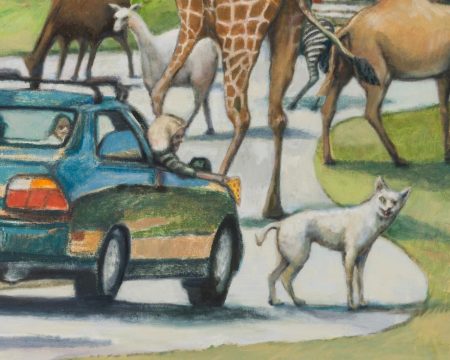Rob Thom’s paintings resemble funhouse mirrors tilted towards pleasure-seeking crowds, magnifying follies and foibles that extend to American culture at large. His works in “The Beast” at M+B depict mostly white middle-class throngs at leisure in typical venues such as zoos, carnivals, and wrestling matches. Each scene appears ordinary enough until you notice comical panoplies of distortions and incongruities slyly embedded in plain sight. It would be difficult to take these paintings seriously were they not so utterly familiar.
It’s just another lazy summer day in Reverse Beach (all works 2019), a seaside vista crawling with pallid potbellies languidly hanging out by the shore. Emerging awkwardly from swimwear, corporeal irregularities are emphasized by Thom’s satirical brush that occasionally forgets to fully flesh out limbs, such as a sunbathing man’s emaciated red-banded forearm attached to a fanlike hand that seems to be turning to rubber. The faux-sophomorishness of Thom’s muddy palette and deliberately disproportionate figures contributes to his scenes’ air of average-Joe absurdity. You can almost smell the sunscreen in his waxy paint-handling. Two ample women near the painting’s left-hand corner sport puttylike faces redolent of clay animations caught awkwardly between frames. Rationality further dwindles when you notice the man with lunatic mirth wielding a chainsaw in the shallows as though it were perfectly normal, even salutary, to take one’s power tools for a dip in the ocean.
In Drive-Thru Zoo, giraffes lope in the company of lions and other wild beasts surrounding a parade of auto traffic. This fast-food zoological park is hardly an Eden. A blonde outstretches her arm from a car window, beaming with self-satisfaction at her own generosity in offering a slice of pepperoni pizza to a hyena who piquantly points his tail end and a sidelong grin in her direction as if to inquire, “Are you for real?” With such expressional aptness, Thom’s portrayed animals appear uniquely anthropic; the flocking human visitors seem more bestial than the specimens they have come to examine.
Small animals are increasingly becoming essential to the survival of Homo sapiens, which, it seems, has evolved to rely upon other, furrier species, particularly those of the canine or feline varieties. As evidenced by the growing number of support animals, many members of the human species are unable to procure their own food, partake in amusement, or travel in the absence of a comforting littler creature. Hence people literally become their pets, and vice versa, in Thom’s Baptism, where motley critters individuate faceless human occupants of a cruise-going crowd. A cat morphs into a woman’s head, a man tenderly cuddles a reddish hen, and an African grey parrot seems keener than his owner of whom all we can see is the back of generic head.
Is that cratered white sphere atop the refuse mountain in The Cold Room supposed to represent a trashed moon, or a giant decorative golf ball? Either scenario could readily bespeak societal priorities. It takes a moment to realize that folk are actually living inside the junk pile; given surging housing costs and homelessness, such a scene isn’t far from reality.
Several paintings of sporting events suggest tribalism and the popular penchant for vicariously experiencing hostility via competitive public spectacle. The multitude of varied spectators in MMAF is unified in petulant clamor. Shouting countenances devolve into cartoonish stereotypes and blatant monstrosities; a green pilgarlic, for instance, recalls popular depictions of Frankenstein’s monster. (If only real-life monsters were so easily spotted.) Yet it’s hard to imagine any contemporary crowd with so few people absorbed by smartphones. Given the scarcity of gadgets, Thom’s paintings seem quaintly a few years behind our time, but are more entertaining for it. Faces rarely appear less amusing than when absorbed by screens.
Peering into Thom’s hordes, you begin to recognize reminders of people you know, and may even discover yourself, though you’d be slow to admit it. His paintings mine modern humor from the timeless fact that any given individual’s peculiarity is magnified in the company of assorted scores, encouraging us not to take ourselves too seriously. Lost in a crowd, anyone becomes a readymade caricature to be plucked from the masses by another’s discerning eyes. All the world’s a cartoon, with all the men and women merely characters.
–Annabel Osberg
Rob Thom’s “The Beast” is on view through May 11 at M+B, 612 N. Almont Dr., Los Angeles, CA 90069, mbart.com












